NDVI stands for "Normalized Difference Vegetation Index". NRG stands for "Near-infrared / Red / Green". NDVI and NRG are both ways to visualize the amounts of infrared and other wavelengths of light reflected from vegetation. Because both these methods compare ratios of blue and red light absorbed versus green and IR light reflected, they can be used to evaluate the health of vegetation. It's a snapshot of how much photosynthesis is happening. This is helpful in assessing vegetative health or stress. (Read more here: https://www.agronomy.org/publications/jeq/articles/36/3/832) ## Do-It-Yourself These techniques for vegetation analysis were developed for satellite imagery, but at Public Lab, we've been working a lot on capturing infrared imagery using our DIY [near-infrared camera](/wiki/near-infrared-camera) setup, and combining it with visible bands to produce NDVI images such as the one above. ## What these images mean What exactly are these images we're trying to make? What do they tell us about vegetation, and why? These diagrams should help to understand what it is we're doing and why these are good ways to analyze plant life. ## The NDVI equation [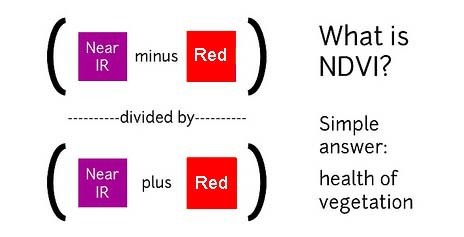](/i/44723) **NDVI = (Near Infrared - Red)/(Near Infrared + Red)** NDVI is a ratio which tries to emphasize photosynthesis while filtering out sun glare. The above equation is run for every pixel, using source data from an infrared photo and a visible light photo, like this pair: [](https://publiclab.org/system/images/photos/000/021/771/original/5390895115_c9d4d38fec_o.jpg) The result can be false-colored to make the high-photosynthesis areas more clear, and used to examine where plants are and how healthy they are. [](https://publiclab.org/system/images/photos/000/021/770/original/PetVISNDVIcomp.png) _Figure above: Normal color photo (right) and normalized difference vegetation index (NDVI) image (left). NDVI image was derived from two color channels in a single photo taken with a camera modified with a special infrared filter. Note that tree trunks, brown grass, and rocks have very low NDVI values because they are not photosynthetic. Healthy plants typically have NDVI values between 0.1 and 0.9. -- @cfastie_ ### Activities Here are a range of activities you can do to produce and interpret your own NDVI imagery, whether downloaded from a satellite imagery provider or [collected yourself using a DIY technique](/wiki/multispectral-imaging) [activities:ndvi] ****   Most DIY converted cameras today (those from Public Lab) use RGN instead of NRG, so the blue channel represents infrared instead of the red channel. That looks like this: [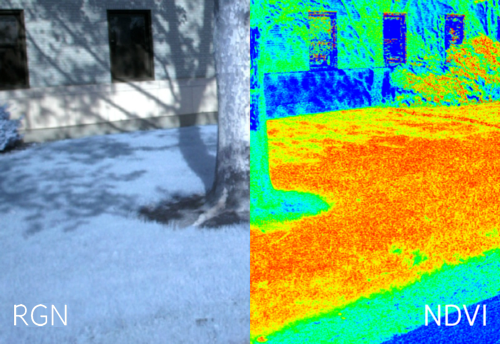](/i/45468?s=o) **** ## NRG imagery Some people are also interested in producing NRG imagery (like the below image), where `Near-Infrared, Red, and Green` are used to compose a picture instead of the usual `Red, Green, and Blue`. [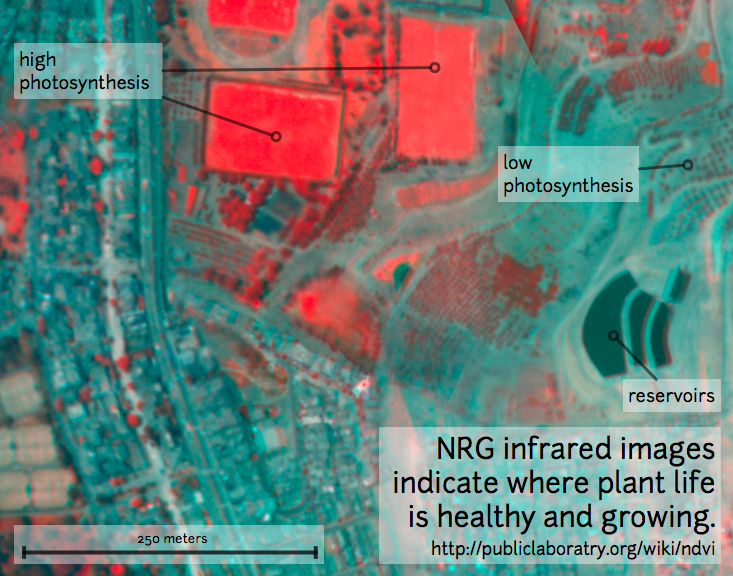](/i/25064) This diagram explains the swapping, which allows us to 'see' infrared as if it were a normal color: [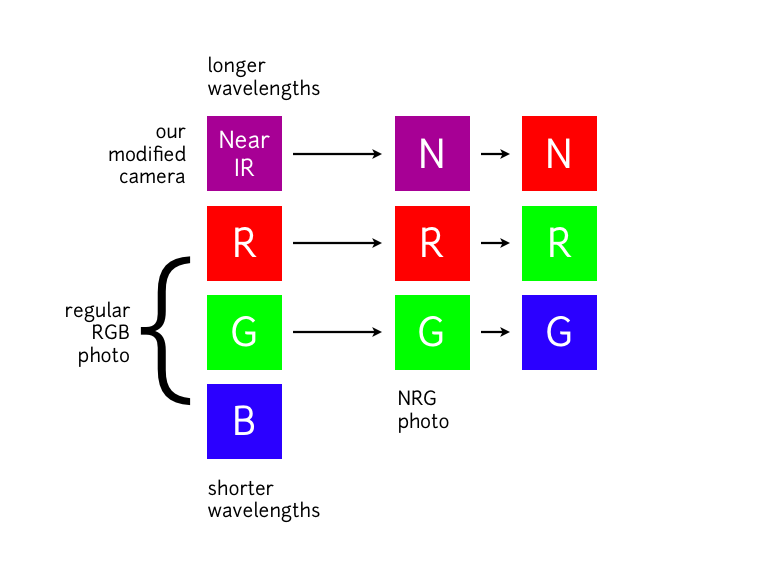](/i/25063) **In NRG images, the deeper and clearer the red color, the denser and healthier the vegetation (more or less).** ### Questions [questions:ndvi] ### Other examples of DIY NDVI imaging From around the internet: Begin watching at 2 minutes to see the resulting imagery: *This topic is part of the [Grassroots Mapping Curriculum](/wiki/mapping-curriculum) series.* **** [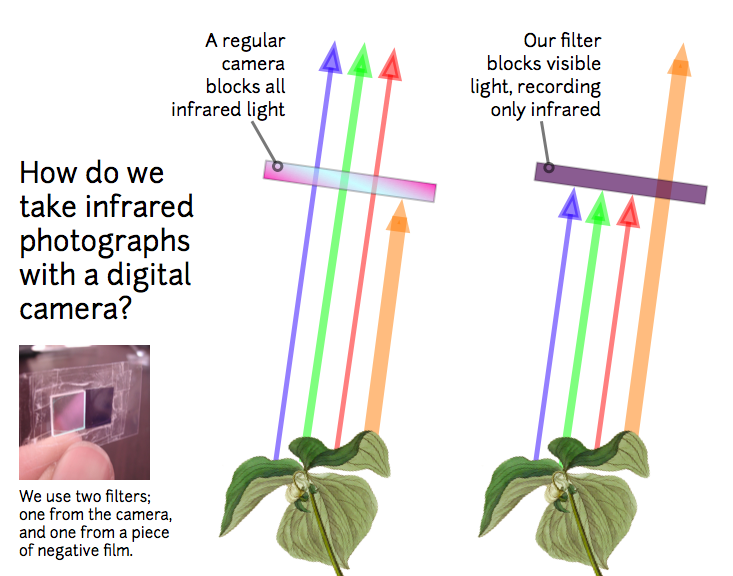](/i/25066) [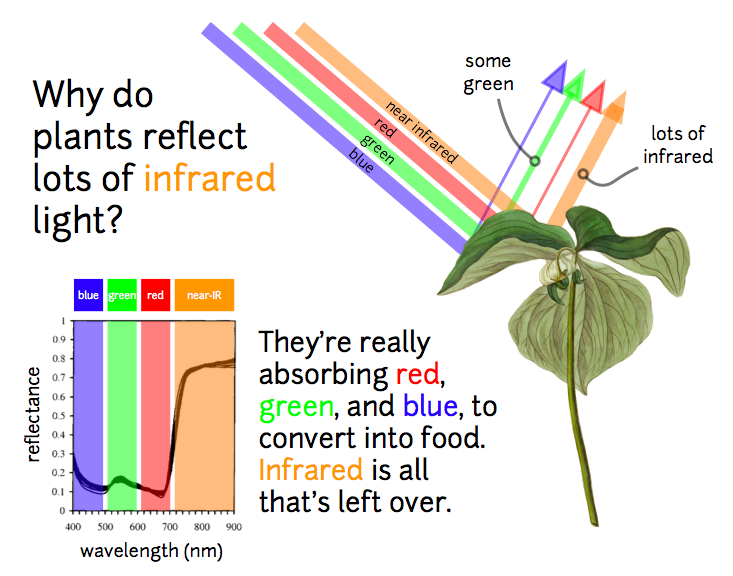](/i/25065) ...
| Author | Comment | Last activity | Moderation | ||
|---|---|---|---|---|---|
| imvec | " @imvec has marked arturunderwater as a co-author. " | Read more » | over 6 years ago | |||
| warren | "Probably! Can you point me at a MODIS source with bands youre interested in? " | Read more » | over 6 years ago | |||
| eustatic | "hunh, can you do this with MODIS? " | Read more » | over 6 years ago | |||
| ccpandhare | "@warren wow this looks very promising!! :-D " | Read more » | over 6 years ago | |||
| jbreen | "@warren I think you may have stumped me. Have you looked at GloVis? glovis.usgs.gov " | Read more » | over 6 years ago | |||
| warren | "@wward1400 @adam-griffith @MicheleTobias @lprashad @eustatic @nedhorning @cfastie you might like this little experiment too! " | Read more » | over 6 years ago | |||
| warren | "@ccpandhare @tech4gt exciting! @jbreen - you'd know this... are there any tiles available for LANDSAT's near-infrared bands? Especially like NGB t..." | Read more » | over 6 years ago | |||
| Hala73 | "Thanks for that, I'll give it a try and let you know how it worked " | Read more » | over 6 years ago | |||
| Hala73 | "I'll give it a try then, thanks! " | Read more » | over 6 years ago | |||
| warren | "We're developing a new system based on Infragram, which is more systematic, and can output things like averages, etc. We're testing this out now an..." | Read more » | over 6 years ago | |||
| warren | "Hi, @Hala73 - Fiji can be installed on a mac, actually -- and ImageJ (same app) on Linux. " | Read more » | over 6 years ago | |||
| Hala73 | "Thank you, these are plugins for PC but I'll look for something similar that works on a mac. " | Read more » | over 6 years ago | |||
| cfastie | "I don't think calculations at Infragram.org can be used for anything but determining the color of a new image. The Photo Monitoring plugin and Fiji..." | Read more » | over 6 years ago | |||
| warren | "Also could be interesting to @maggpi -- check it out! " | Read more » | over 6 years ago | |||
| sjmanosalvas | "@carolccarvalho please your help, I trying to do a similar project for school, but I'm new with MATLAB program, Could you send your codes to implem..." | Read more » | over 6 years ago | |||
| sjmanosalvas | "Please your help, I bought the Blue and Red Filter (https://publiclab.myshopify.com/collections/diy-infrared-photography/products/infragram-diy-fil..." | Read more » | over 6 years ago | |||
| cfastie | "Incandescent or halogen lamps emit lots of NIR. Fluorescent, sodium, mercury, and LED lamps do not. The image below is from here: http://perfecthea..." | Read more » | over 6 years ago | |||
| JLJ | "Hello Chris, thank you for the swift and detailed response. Do you have any recommendations for a light source that I can buy? " | Read more » | over 6 years ago | |||
| cfastie | "It is possible to compute a facsimile of NDVI from a single photo taken with a Pi NoIR camera and blue filter. The blue channel in the photo will c..." | Read more » | over 6 years ago | |||
| cfastie | "Probably good that they didn't contact me. I would have said only "Blue filter?" " | Read more » | over 6 years ago | |||
| nedhorning | "Yes - the author contacted me shortly before posting the blog " | Read more » | over 6 years ago | |||
| warren | "@nedhorning @cfastie did you hear about this? We just learned of it! Amazing :-) " | Read more » | over 6 years ago | |||
| csteran | "Thank you so much! " | Read more » | over 6 years ago | |||
| tech4gt | "@csteran actually image-sequencer has the capability to run a sequence of processing steps on an image and provide output of each step separately o..." | Read more » | almost 7 years ago |